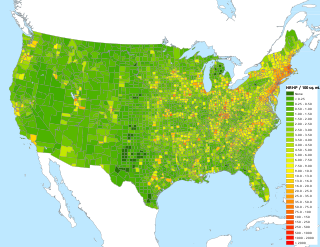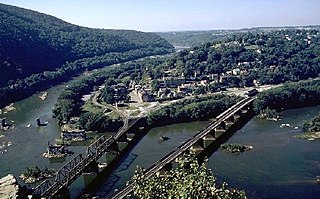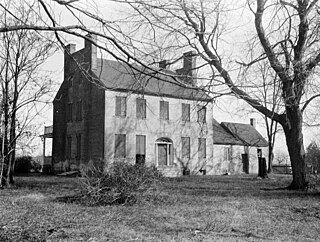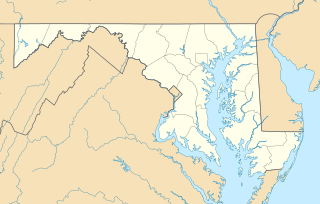
Point of Rocks is an unincorporated community and census-designated place (CDP) in Frederick County, Maryland, United States. As of the 2010 census it had a population of 1,466. It is named for the striking rock formation on the adjacent Catoctin Mountain, which was formed by the Potomac River cutting through the ridge in a water gap, a typical formation in the Appalachian Mountains. The formation is not visible from the town and can only be seen from boats on the river, or from the southern bank of the river in Virginia.

Marshall Hall, Maryland is the site of the Marshall family mansion. It is now part of Piscataway Park operated by the National Park Service. Marshall Hall is located near Bryan's Road in Charles County, Maryland, next to the Potomac River, more or less across from Mount Vernon, Virginia, the home of George Washington. The home was one of the finest built on the Maryland shore of the Potomac in the early 18th century. The Marshall family were minor gentry and owned as many as 80 slaves by the early 19th century.

Marshall is a census-designated place (CDP) and unincorporated town in northwestern Fauquier County, Virginia, in the United States. The population as of the 2010 census was 1,480.

The National Register of Historic Places in the United States is a register including buildings, sites, structures, districts, and objects. The Register automatically includes all National Historic Landmarks as well as all historic areas administered by the U.S. National Park Service. Since its introduction in 1966, more than 90,000 separate listings have been added to the register.

Bloomington is an unincorporated community and census-designated place (CDP) locates in southeastern Garrett County, Maryland located at the confluence of the North Branch Potomac River and Savage River. It lies to the west of Luke on Maryland Route 135 and is bounded to the northwest by Savage River State Forest. As of the 2010 census the population of Bloomington was 305.

The Bloomington Viaduct spans the Northern Branch of the Potomac River connecting Bloomington, Maryland to Mineral County, West Virginia. The sandstone railroad bridge features three full center arches, each with a 56-foot span and a 28-foot rise. It is owned and operated by CSX Transportation on its Mountain Subdivision.

Piscataway Park, located 20 miles (32 km) southwest of downtown Washington, D.C., in and around Accokeek, Maryland, protects Marshall Hall, the National Colonial Farm, and the Accokeek Creek Site. The park is located across the Potomac River from George Washington's Mount Vernon estate.

Flintstone is an unincorporated community and census-designated place (CDP) in Allegany County, Maryland, United States. As of the 2010 census it had a population of 177. It is part of the Cumberland, MD-WV Metropolitan Statistical Area.

Oxon Cove Park and Oxon Cove Farm is a national historic district that includes a living farm museum operated by the National Park Service, and located at Oxon Hill, Prince George's County, Maryland. It is part of National Capital Parks-East. It was listed on the National Register of Historic Places in 2003.

The Baltimore and Ohio Railroad Crossings at the Potomac River are a set of railroad bridges that span the Potomac River between Maryland Heights, Maryland and Harpers Ferry, West Virginia in the United States.
The Monocacy Site is an archeological site located along the Potomac River. The site spans several eras ranging from Archaic period to the early Woodland period. Projectile points, pottery and soapstone vessels have been found here, with pottery dated to c. 1145-865 BC. The site is the deepest known stratified site in Maryland.

Waverley is a historic home located near Morgantown, Charles County, Maryland. It is a large two story, five-bay, Flemish-bond brick house, that faces the Potomac River. All interior woodwork is characteristic of the Federal period.

The Meyer Site is an archaeological site near Westernport in Garrett County, Maryland, United States. It is located along Chestnut Grove Road on the riverside edge of an alluvial bottom on the west side of the North Branch of the Potomac River. It is the site of a Monongahela culture village, which is the uppermost Late Prehistoric village known on the North Branch.

Faulkner is an unincorporated community in Charles County, Maryland, United States. It is home to the Loyola Roman Catholic retreat center. Near here, John Wilkes Booth, assisted by Thomas A. Jones of Huckleberry Farm, was rowed across the Potomac River into Virginia, a week after he assassinated President Abraham Lincoln. The community was called Lothair before being renamed for a local resident.

Bel Alton is an unincorporated community in Charles County, Maryland, United States. It is marked by old-style motels, a popular "bikers'" tavern, and other small businesses along U.S. Highway 301 catering to local residents and interstate travelers. A series of interpretive signs on a side road mark various spots where, in April 1865, John Wilkes Booth stopped to hide during his flight south after assassinating President Abraham Lincoln. St. Ignatius Church and cemetery, the oldest continuous Roman Catholic parish in the United States, is two miles west of Bel Alton on a scenic bluff overlooking a wide inlet of the Potomac River. The county fairgrounds are also nearby. The former Bel Alton African American high school building is now used for community activities. Before 1891, Bel Alton was known as Cox's Station after a local resident. The area is poised for growth as construction has started on a housing development, "Stagecoach Crossing", two miles north.

Skidmore is an unincorporated community in Anne Arundel County, Maryland, United States. The community is the western terminus of the Chesapeake Bay Bridge as well as the location of Sandy Point State Park. Sandy Point Shoal Light was listed on the National Register of Historic Places in 2002.

Jerusalem is an unincorporated community in Harford County, Maryland, United States. It is the location of the historic Jerusalem Mill Village and Jericho Covered Bridge, both listed on the National Register of Historic Places. Jerusalem Mill Village is located on Jerusalem Road in Kingsville, MD between the Little Gunpowder Falls river and Jericho Road.

Knoxville is an unincorporated community in Frederick and Washington counties, Maryland, United States. The Robert Clagett Farm and Magnolia Plantation are listed on the National Register of Historic Places.

Potomac–Broadway Historic District is a national historic district at Hagerstown, Washington County, Maryland, United States. The district is located in the north downtown area and consists largely of a late 19th and early 20th century residential area with most buildings dating from 1870-1930. Architectural styles represented include Victorian Gothic, Queen Anne, Colonial Revival, and American Foursquare.

Mason Springs is an unincorporated community in Charles County, Maryland, United States. Mason Springs is located at the junction of Maryland routes 224 and 225, 1.8 miles (2.9 km) southeast of Potomac Heights. The community had a post office from 1890 to 1924.















